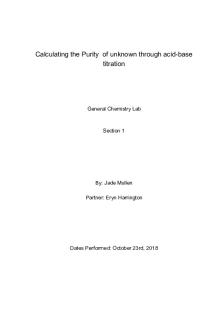Back titration - chem lab report PDF

| Title | Back titration - chem lab report |
|---|---|
| Author | Reginald Aikins |
| Course | Biochemistry For The Medical Sciences |
| Institution | University of Miami |
| Pages | 2 |
| File Size | 71.2 KB |
| File Type | |
| Total Downloads | 67 |
| Total Views | 147 |
Summary
chem lab report...
Description
REGINALD AIKINS SECTION: JX TA: YETING ZHENG OCTOBER 7, 2019
Preparing Standardized Solutions Purpose and theory: Soda ash, also known as sodium carbonate or Na2CO3, is an impure and important commercial inorganic chemical. It is a raw material of chemicals, glass, detergents, and other important industrial products. Soda ash’s impurities can be titrated with a strong acid, but the titration occurs in two stages. The easiest way to perform these two stages is to use a back titration. Using this kind of titration requires excess acid to be added and allowed to react completely with the carbonate. The solution is briefly boiled to remove the CO 2. After cooling, the excess acid still present in the solution is titrated with NaOH. The purpose of this lab it to perform a successful back titration and then use the data collected from the titration to calculate the perfect Na2CO3 in the unknown sample. A back titration has to be performed to titrate CO3 - with a strong acid. The titration comes in two stages: CO32- + H+
HCO3- + H+
H2CO3
H2O + CO2
The following formulas are also used to analyze the data: Volume HCl added X (Mol HCl/ml) = mmol HCl added Volume NaOH added X (Mol NaOH/ml) = mmol NaOH added Net mmol HCl to titrate soda ash = volume NaOH added – mmol NaOH added Mmol Na2CO3 titrated = net mmol HCl to titrated soda ash X (1 mmol Co32-/2 mmol HCl) % Na2CO3 = (mass of Na2CO3 in soda ash sample/original mass of soda ash) X100
Procedure: 1. Dry the unknown sample of soda ash for 1.5 hours to constant weight in the drying oven at 120C & allow to cool before weighing 2. Use a tarred weigh boat to accurately weigh two about .4g samples of the unknown to four decimal places & fully transfer each sample into a clean & dry 250 mL Erlenmeyer flask that has been labeled 3. When ready to titrate, add about 50 mL of distilled water, dissolve by swirling the solution, & add 3 drops phenolphthalein 4. Rinse & fill a buret with your standardized HCl solution & titrate the first soda ash sample to the disappearance of the pink color 5. Add an additional volume of HCl about equal to the amount added in Step 4, then add 10 mL more HCl 6. Bring solution to a boil & boil 5 minutes. Cool to room temperature & add 3 drops phenolphthalein 7. Rinse & fill a buret with your standardized NaOH solution. Back titrate the cooled soda ash sample to the phenolphthalein endpoint (pink color) 8. Repeat steps 3-7 for second sample of dilute impure soda ash solution. 9. Calculate & report the % Na2CO3 in the sample
Data and Calculations: Attached
Discussions and Conclusions: The % values gotten from both titrated Soda ash sample were very close and consistent which showed that the back titration was conducted well. There could have been some possible errors though. Errors could have come from the balances used to weight the sodium carbonate. If the balances were not calibrated correctly, the weight of the sodium carbonate would be incorrect, and this would result in all further calculations being wrong. Another possible source of error could have been using in properly standardized solutions of HCl and NaOH. If the burets contained gas bubbles, the volume of NaOH and HCl would be incorrect. This would skew all calculations done afterwards. Back titrations can be useful when titrating samples that have two stages and impurities that need to be titrated out. Overall, this experiment was successful in teaching how to calculate percent sodium carbonate in an unknown sample by performing a back titration....
Similar Free PDFs

Back titration - chem lab report
- 2 Pages

Titration Worksheet - Lab Report
- 2 Pages

Titration Tutorial Lab Chem 113
- 2 Pages

Example back titration
- 2 Pages

Lab Report titration curve
- 7 Pages

Acid base titration lab report
- 5 Pages

Acid-Base Titration Lab Report
- 7 Pages

Chem Lab report 1 - Chem lab 1
- 4 Pages

Chem Lab report
- 3 Pages

Chem lab 9 - lab report
- 3 Pages

Chem lab 10 - lab report
- 9 Pages

CHEM LAB 12 - lab report
- 4 Pages

Chem - Lab report
- 3 Pages

Chem Lab Report 1
- 7 Pages
Popular Institutions
- Tinajero National High School - Annex
- Politeknik Caltex Riau
- Yokohama City University
- SGT University
- University of Al-Qadisiyah
- Divine Word College of Vigan
- Techniek College Rotterdam
- Universidade de Santiago
- Universiti Teknologi MARA Cawangan Johor Kampus Pasir Gudang
- Poltekkes Kemenkes Yogyakarta
- Baguio City National High School
- Colegio san marcos
- preparatoria uno
- Centro de Bachillerato Tecnológico Industrial y de Servicios No. 107
- Dalian Maritime University
- Quang Trung Secondary School
- Colegio Tecnológico en Informática
- Corporación Regional de Educación Superior
- Grupo CEDVA
- Dar Al Uloom University
- Centro de Estudios Preuniversitarios de la Universidad Nacional de Ingeniería
- 上智大学
- Aakash International School, Nuna Majara
- San Felipe Neri Catholic School
- Kang Chiao International School - New Taipei City
- Misamis Occidental National High School
- Institución Educativa Escuela Normal Juan Ladrilleros
- Kolehiyo ng Pantukan
- Batanes State College
- Instituto Continental
- Sekolah Menengah Kejuruan Kesehatan Kaltara (Tarakan)
- Colegio de La Inmaculada Concepcion - Cebu

